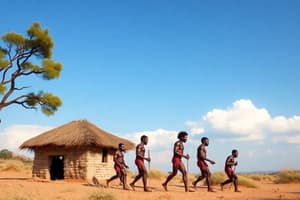Podcast
Questions and Answers
What is the primary purpose of cultural resource management (CRM)?
What is the primary purpose of cultural resource management (CRM)?
- To excavate buried artifacts
- To create new archaeological sites
- To promote tourism in historic areas
- To conduct compliance with laws for conserving cultural resources (correct)
Which act prohibits the excavation or collection of archaeological sites on public lands without a permit?
Which act prohibits the excavation or collection of archaeological sites on public lands without a permit?
- Cultural Resources Management Act
- Native American Graves Protection and Repatriation Act
- Antiquities Act (correct)
- National Historic Preservation Act
What percentage of fieldwork is conducted within the realm of cultural resource management today?
What percentage of fieldwork is conducted within the realm of cultural resource management today?
- 90% (correct)
- 70%
- 50%
- 100%
Which section of the National Historic Preservation Act requires the government to consider the effects of its actions on historic properties?
Which section of the National Historic Preservation Act requires the government to consider the effects of its actions on historic properties?
What criteria does the National Register of Historic Places NOT include?
What criteria does the National Register of Historic Places NOT include?
Which of the following is NOT considered a cultural resource?
Which of the following is NOT considered a cultural resource?
What is one primary responsibility of State Historic Preservation Officers (SHPOs)?
What is one primary responsibility of State Historic Preservation Officers (SHPOs)?
Which statement about cultural resources is true?
Which statement about cultural resources is true?
What is the primary purpose of NAGPRA?
What is the primary purpose of NAGPRA?
Which of the following is considered a funerary object under NAGPRA?
Which of the following is considered a funerary object under NAGPRA?
Which course is least relevant for preparation in a career in Cultural Resource Management (CRM)?
Which course is least relevant for preparation in a career in Cultural Resource Management (CRM)?
What does cultural affiliation mean in the context of NAGPRA?
What does cultural affiliation mean in the context of NAGPRA?
What key issue does the Kennewick Burial case highlight?
What key issue does the Kennewick Burial case highlight?
Which of the following agencies is required to consult with tribes under NAGPRA?
Which of the following agencies is required to consult with tribes under NAGPRA?
What is the significance of Walter Echo-Hawk's statement regarding Native American remains?
What is the significance of Walter Echo-Hawk's statement regarding Native American remains?
Which of the following is not explicitly prohibited under NAGPRA?
Which of the following is not explicitly prohibited under NAGPRA?
Flashcards
Cultural Resource Management (CRM)
Cultural Resource Management (CRM)
A professional field focused on conserving cultural resources by complying with laws.
Cultural Resources
Cultural Resources
Historic structures, landscapes, archaeological sites, shipwrecks, artifacts, and religious sites.
Archaeological Resources Protection Act
Archaeological Resources Protection Act
Federal law protecting archaeological resources on public lands.
National Historic Preservation Act
National Historic Preservation Act
Signup and view all the flashcards
National Register of Historic Places
National Register of Historic Places
Signup and view all the flashcards
Section 106 (of the NHPA)
Section 106 (of the NHPA)
Signup and view all the flashcards
Antiquities Act (1906)
Antiquities Act (1906)
Signup and view all the flashcards
CRM Archaeology Phases
CRM Archaeology Phases
Signup and view all the flashcards
NAGPRA
NAGPRA
Signup and view all the flashcards
Cultural Affiliation (NAGPRA)
Cultural Affiliation (NAGPRA)
Signup and view all the flashcards
Kennewick Burial
Kennewick Burial
Signup and view all the flashcards
Human Remains (NAGPRA)
Human Remains (NAGPRA)
Signup and view all the flashcards
Funerary Objects (NAGPRA)
Funerary Objects (NAGPRA)
Signup and view all the flashcards
Sacred Objects (NAGPRA)
Sacred Objects (NAGPRA)
Signup and view all the flashcards
Objects of Cultural Patrimony (NAGPRA)
Objects of Cultural Patrimony (NAGPRA)
Signup and view all the flashcards
Preparation for a career in CRM
Preparation for a career in CRM
Signup and view all the flashcards
Study Notes
Cultural Resource Management (CRM)
- CRM is a professional field focused on activities related to complying with laws that aim to preserve cultural resources.
- Cultural resources include historic structures, cultural landscapes, archaeological sites, shipwrecks, artifacts, and religious sites.
- Cultural resources are considered important and non-renewable, so they must be taken into consideration when making development decisions.
Key Laws
- Archaeological Resources Protection Act: A law regarding protecting archaeological resources.
- National Historic Preservation Act: A law focused on preserving historic and cultural resources.
- Native American Graves Protection and Repatriation Act (NAGPRA): Key law governing Native American cultural heritage.
NAGPRA (1990)
- Inventory/Identification: Museums and universities are required to inventory Native American remains and cultural items in their collections and determine affiliations.
- Consultation: Institutions must consult with tribes about items or remains.
- Repatriation: Culturally affiliated human remains, funerary objects, sacred objects, and objects of cultural patrimony must be returned to the affiliated tribes when requested.
- Protection of Burials: Intentional excavation and removal of Native American remains or cultural items from federal and tribal lands is prohibited without tribal consent.
Key Terms in NAGPRA
- Human Remains: Physical remains of individuals (bones, teeth, etc.) whether fully or partially intact, relating to Native American ancestry.
- Funerary Objects: Items intentionally placed with human remains as part of a burial ceremony.
- Sacred Objects: Ceremonial items needed by Native American religious leaders for traditional tribal practices.
- Objects of Cultural Patrimony: Items with ongoing historical, traditional, or cultural significance to a tribe, considered communal property.
Cultural Affiliation (under NAGPRA)
- Cultural affiliation is defined as a relationship of shared group identity (historically or prehistorically) between a present-day tribe/Native Hawaiian organization and an identifiable earlier group.
Antiquities Act (1906)
- It is illegal to excavate or collect archeological items on public lands without a permit.
- Permits are only granted to museums, universities, and other scientific or educational institutions.
- The President can create national monuments on federal lands to be protected.
National Historic Preservation Act (1966)
- Aims to preserve important historic, cultural, and natural aspects of national heritage.
- Provides a nationwide program for historic preservation.
- Includes significant sections (e.g., 110, 106) that address government responsibility for inventorying, protecting, and considering the impact of actions on historic properties.
NRHP Criteria
- Criteria for listing properties on the National Register of Historic Places.
- Events, important people, design/construction, and information (info important for history or prehistory).
Kennewick Burial
- 9000 years old.
- Discovery in 1996.
- Questions of descendants and cultural identification.
- Legal battles regarding repatriation.
- Eventually reburied in 2017 by Columbia River tribes.
Preparation for a Career in CRM
- Required courses in Anthropology, History, Environmental Studies, Conservation Studies.
- Business courses
- Strong math and statistics skills
- GIS (Geographic Information Systems)
- Computer modeling skills
- Technical writing skills
Studying That Suits You
Use AI to generate personalized quizzes and flashcards to suit your learning preferences.




